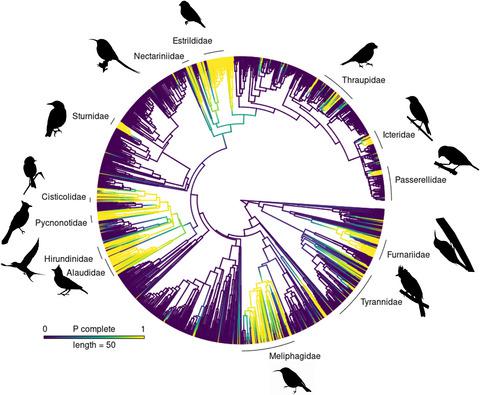当前位置:
X-MOL 学术
›
J. Anim. Ecol.
›
论文详情
Our official English website, www.x-mol.net, welcomes your
feedback! (Note: you will need to create a separate account there.)
Partial or complete? The evolution of post‐juvenile moult strategies in passerine birds
Journal of Animal Ecology ( IF 3.5 ) Pub Date : 2020-10-15 , DOI: 10.1111/1365-2656.13354 Kaspar Delhey 1 , Santiago Guallar 2 , Rafael Rueda‐Hernández 3 , Mihai Valcu 1 , Daiping Wang 1 , Bart Kempenaers 1
Journal of Animal Ecology ( IF 3.5 ) Pub Date : 2020-10-15 , DOI: 10.1111/1365-2656.13354 Kaspar Delhey 1 , Santiago Guallar 2 , Rafael Rueda‐Hernández 3 , Mihai Valcu 1 , Daiping Wang 1 , Bart Kempenaers 1
Affiliation

|
Moulting strategies in birds have evolved to avoid overlap with, or prepare for, other demanding parts of the annual cycle, such as reproduction or migration. When moulting for the first time after leaving the nest, young birds replace their typically poor-quality plumage during the post-juvenile moult. The extent of this moult varies between species from partial to complete. Earlier studies, restricted to Western Palearctic birds, suggest that in most species a complete post-juvenile moult may not be possible simply because young birds are constrained by not having the same access to resources as adults, unless environmental conditions are favourable. These studies also show that complete post-juvenile moult is more common in species with poor-quality nest-grown plumage. We expanded the spatial and taxonomic scope of previous studies to 1315 species of passerines from across the world and considered both the role of constraints, plumage quality and other selective pressures favouring a complete post-juvenile moult. Thus, we test whether complete moult is more prevalent in species where nest-grown feathers are presumably of poor quality (shorter nestling period), that live in environments that foster quick plumage degradation (open habitats, high insolation and humidity), and where males are under strong sexual selection. Our data reveal that 24% of species carry out a complete post-juvenile moult, and that this trait has a strong phylogenetic signal. Complete moult is more common in species that inhabit warmer regions and open habitats, show no delayed plumage maturation, and have higher levels of sexual dichromatism (indicative of strong sexual selection). Neither the presumed quality of the nest-grown plumage, nor living in regions with high insolation correlates with complete moult. In conclusion, the evolution of complete post-juvenile moult not only depends on whether birds can perform a complete moult (i.e. suitable environmental conditions) but also on the strength of selection associated with the need of a complete moult. In particular, the necessity to keep the plumage in good condition in challenging environments, and the benefits associated with producing adult-like plumage colours to attract mates or deter rivals, seem to play an important role.
中文翻译:

部分还是完整?雀形鸟幼龄后换羽策略的演变
鸟类的换羽策略已经演变为避免与年度周期中其他要求苛刻的部分(例如繁殖或迁徙)重叠或为之做好准备。离开巢穴后第一次换羽时,幼鸟会在幼鸟换羽后更换它们通常质量较差的羽毛。这种蜕皮的程度因物种而异,从部分到完全。早期的研究仅限于西部古北鸟类,表明在大多数物种中,完整的幼鸟后蜕皮可能是不可能的,因为幼鸟无法获得与成鸟相同的资源,除非环境条件有利。这些研究还表明,完整的幼年后蜕皮在具有劣质巢状羽毛的物种中更为常见。我们将先前研究的空间和分类范围扩大到来自世界各地的 1315 种雀形目,并考虑了约束的作用、羽毛质量和其他有利于完整的幼鱼后蜕皮的选择压力。因此,我们测试了完全换羽是否在以下物种中更为普遍:巢内生长的羽毛可能质量较差(雏鸟期较短)、生活在促进羽毛快速退化的环境中(开放的栖息地、高日照和湿度)以及雄性处于强烈的性选择之下。我们的数据显示,24% 的物种进行了完整的幼年后换羽,并且该特征具有很强的系统发育信号。完全蜕皮在栖息于温暖地区和开阔栖息地的物种中更常见,没有表现出延迟的羽毛成熟,并且具有更高水平的性二色性(表明强烈的性选择)。巢内生长的羽毛的假定质量或生活在高日照地区都与完全换羽无关。总而言之,幼龄后完全换羽的进化不仅取决于鸟类是否可以进行完全换羽(即合适的环境条件),还取决于与完全换羽需要相关的选择强度。特别是,在具有挑战性的环境中保持羽毛处于良好状态的必要性,以及与产生类似成人的羽毛颜色以吸引配偶或威慑竞争对手相关的好处,似乎发挥了重要作用。生活在高日照地区也与完全蜕皮有关。总而言之,幼龄后完全换羽的进化不仅取决于鸟类是否可以进行完全换羽(即合适的环境条件),还取决于与完全换羽需要相关的选择强度。特别是,在具有挑战性的环境中保持羽毛处于良好状态的必要性,以及与产生类似成人的羽毛颜色以吸引配偶或威慑竞争对手相关的好处,似乎发挥了重要作用。生活在高日照地区也与完全蜕皮有关。总而言之,幼龄后完全换羽的进化不仅取决于鸟类是否可以进行完全换羽(即合适的环境条件),还取决于与完全换羽需要相关的选择强度。特别是,在具有挑战性的环境中保持羽毛处于良好状态的必要性,以及与产生类似成人的羽毛颜色以吸引配偶或威慑竞争对手相关的好处,似乎发挥了重要作用。
更新日期:2020-10-15
中文翻译:

部分还是完整?雀形鸟幼龄后换羽策略的演变
鸟类的换羽策略已经演变为避免与年度周期中其他要求苛刻的部分(例如繁殖或迁徙)重叠或为之做好准备。离开巢穴后第一次换羽时,幼鸟会在幼鸟换羽后更换它们通常质量较差的羽毛。这种蜕皮的程度因物种而异,从部分到完全。早期的研究仅限于西部古北鸟类,表明在大多数物种中,完整的幼鸟后蜕皮可能是不可能的,因为幼鸟无法获得与成鸟相同的资源,除非环境条件有利。这些研究还表明,完整的幼年后蜕皮在具有劣质巢状羽毛的物种中更为常见。我们将先前研究的空间和分类范围扩大到来自世界各地的 1315 种雀形目,并考虑了约束的作用、羽毛质量和其他有利于完整的幼鱼后蜕皮的选择压力。因此,我们测试了完全换羽是否在以下物种中更为普遍:巢内生长的羽毛可能质量较差(雏鸟期较短)、生活在促进羽毛快速退化的环境中(开放的栖息地、高日照和湿度)以及雄性处于强烈的性选择之下。我们的数据显示,24% 的物种进行了完整的幼年后换羽,并且该特征具有很强的系统发育信号。完全蜕皮在栖息于温暖地区和开阔栖息地的物种中更常见,没有表现出延迟的羽毛成熟,并且具有更高水平的性二色性(表明强烈的性选择)。巢内生长的羽毛的假定质量或生活在高日照地区都与完全换羽无关。总而言之,幼龄后完全换羽的进化不仅取决于鸟类是否可以进行完全换羽(即合适的环境条件),还取决于与完全换羽需要相关的选择强度。特别是,在具有挑战性的环境中保持羽毛处于良好状态的必要性,以及与产生类似成人的羽毛颜色以吸引配偶或威慑竞争对手相关的好处,似乎发挥了重要作用。生活在高日照地区也与完全蜕皮有关。总而言之,幼龄后完全换羽的进化不仅取决于鸟类是否可以进行完全换羽(即合适的环境条件),还取决于与完全换羽需要相关的选择强度。特别是,在具有挑战性的环境中保持羽毛处于良好状态的必要性,以及与产生类似成人的羽毛颜色以吸引配偶或威慑竞争对手相关的好处,似乎发挥了重要作用。生活在高日照地区也与完全蜕皮有关。总而言之,幼龄后完全换羽的进化不仅取决于鸟类是否可以进行完全换羽(即合适的环境条件),还取决于与完全换羽需要相关的选择强度。特别是,在具有挑战性的环境中保持羽毛处于良好状态的必要性,以及与产生类似成人的羽毛颜色以吸引配偶或威慑竞争对手相关的好处,似乎发挥了重要作用。










































 京公网安备 11010802027423号
京公网安备 11010802027423号